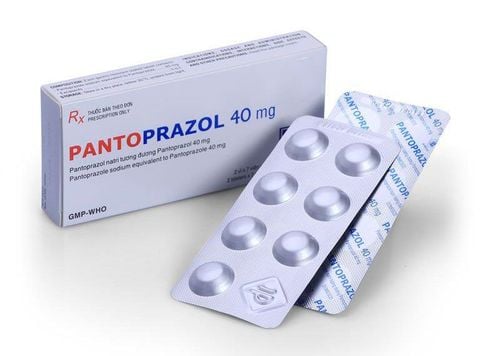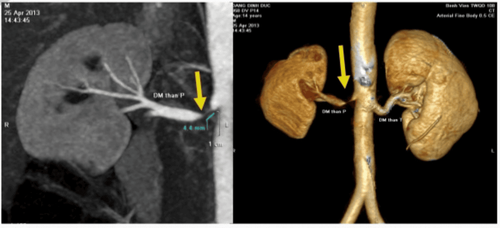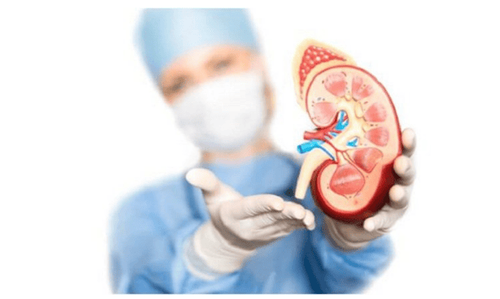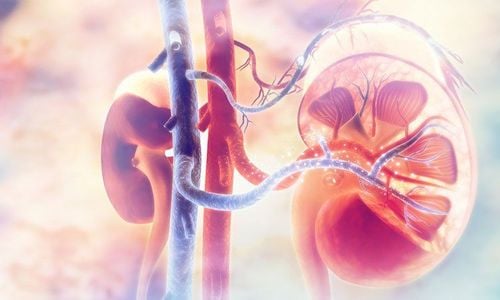This is an automatically translated article.
The article is professionally consulted by Master, Doctor Le Thi Minh Huong - Doctor of Resuscitation - Emergency, Department of Resuscitation - Emergency, Vinmec Nha Trang International General HospitalThe function of the kidneys is to clean the blood and keep fluids and electrolytes in balance. Blood in the circulatory system is carried to the kidneys through the renal artery. In renal vascular disease, the arteries can narrow or become blocked. As a result, the body's vital filtering system is damaged, causing high blood pressure and/or kidney failure.
1. What are renal artery diseases?
Renal artery disease is the collective name given to a variety of complications that affect the arteries in the kidneys. This disease often affects the blood circulation of the kidneys and causes tissue damage, kidney failure and/or high blood pressure.Vascular conditions that affect the arteries include:
1.1 Renal artery stenosis Renal artery stenosis is a blockage of an artery to the kidney, which can cause kidney failure and high blood pressure. Smokers are at increased risk of developing renal artery stenosis and severe complete renal artery occlusion.
It is most common in men between the ages of 50 and 70. High cholesterol, diabetes, being overweight and having a family history of cardiovascular disease are also risk factors for renal artery stenosis. In particular, high blood pressure is both a cause and a result of this renal artery disease.
1.2 Renal artery thrombosis Renal artery thrombosis is the formation of a blood clot in an artery. This renal artery disease can cause kidney failure because blood flow to the kidneys is blocked.
1.3 Renal artery aneurysm A renal artery aneurysm is a bulge, caused by a weakening in the wall of an artery to the kidney. Most of these aneurysms are small and asymptomatic.
Renal artery aneurysms are uncommon and are often discovered during diagnostic procedures in association with other conditions.
1.4 Atherosclerosis of the Kidneys Atherosclerotic renal artery disease occurs when a piece of plaque from the aorta and/or other large arteries ruptures and travels through the bloodstream, blocking the small arteries.
Atherosclerotic renal artery disease is becoming a common cause of kidney failure (poor kidney function) in the elderly.
2. What causes kidney vascular diseases?
The cause of renal vascular disease depends on the condition involved such as:2.1 Renal artery stenosis Narrowing or occlusion of the renal artery may be due to atherosclerosis (ie, accumulation of plaque, deposition of fat, cholesterol, cellular waste products, calcium and fibrin in the inner lining of the arteries) or other conditions, such as: Fibromyalgia, Takayasu's arteritis, etc. major cause of renal artery stenosis.
2.2 Renal artery thrombosis The formation of a thrombus inside one of the renal arteries can occur as a result of trauma, infection, inflammatory disease, renal aneurysm, renal cell cancer, or fibromuscular dysplasia .
2.3 Renal artery aneurysms Renal artery aneurysms can occur due to congenital weakening of the artery wall or trauma. Atherosclerosis can also be a factor.
Another cause of renal aneurysm can also be fibromuscular dysplasia. On the other hand, if the intra-adrenal aneurysm can be congenital or traumatic.
2.4 Atherosclerosis of the Kidneys Small pieces of plaque from plaque formation in other arteries of the body can break off and travel to the renal arteries, blocking blood flow to the kidneys.
Besides, renal artery occlusion can also occur due to surgery, catheterization or use of blood thinners. This disease usually affects older people.
In addition, a person can develop renal vascular disease if risk factors include:
Age; Female gender; Atherosclerosis; Hypertension, especially new-onset hypertension in the elderly; Smoke; High cholesterol; Diabetes.
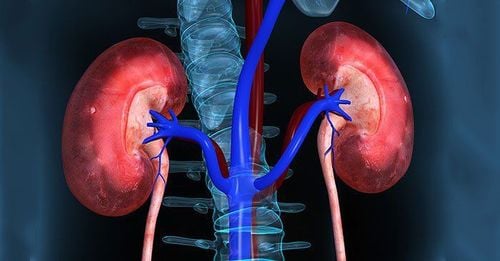
3. What are the symptoms of renal artery disease?
Symptoms of renal artery disease vary, specifically:3.1 Renal artery stenosis Sudden elevation of blood pressure before age 50 suggests stenosis related to fibromuscular dysplasia; Sudden onset of hypertension at or after age 50 suggests atherosclerotic stenosis; Hypertension unresponsive to 3 or more blood pressure medications; Increased blood urea; Kidney failure of unknown cause; Sudden kidney failure when first taking an ACE inhibitor to treat blood pressure and/or heart disease. 3.2 Renal artery thrombosis Acute complete obstruction (sudden): Sudden onset of flank pain; Fever; Blood in the urine; Nausea and/or vomiting; Sudden decrease in kidney function; Hypertension. Gradual or incomplete blockages: may be asymptomatic and undetected 3.3 Renal artery aneurysms Generally asymptomatic; Hypertension may be present in 90% of people with renal aneurysms; Aneurysms (due to a tear in the inner lining of the artery wall) can cause lower quadrant pain and hematuria. 3.4 Renal Atherosclerosis Skin lesions such as purpura; Kidney failure (sudden or occurs over a long period of time); Stomachache; Diarrhea ; Weight loss; Fever; Muscle pain.
4. How to diagnose renal artery disease?
The diagnostic procedure for renal vascular disease may include:Angiography: X-ray images of blood vessels are used to evaluate various conditions, such as aneurysms, narrowing, or blockages congestion. Contrast is injected into the body to make the blood vessels more visible on an X-ray. Color Doppler Ultrasound: This is a type of vascular ultrasound procedure done to evaluate blood flow and the structure of the renal artery. Magnetic Resonance Angiography: Noninvasive diagnostic procedure that uses a combination of magnetic resonance imaging and intravenous contrast to visualize the arteries. Contrast makes blood vessels more visible on the film, allowing doctors to identify lesions and diagnose renal vascular diseases accurately.

5. How to treat kidney vascular diseases
Specific treatment for renal artery disease will be determined by your doctor based on:Age, overall health and medical history; The extent of the disease; Signs and symptoms ; Responsiveness to specific medications, procedures, or therapies; Expectations about the course of the disease; The patient's wishes and choices; Treatment will also vary depending on the type of renal artery disease you have as follows:
5.1 Renal artery stenosis Medical treatment:
Antihypertensives may be used to treat high blood pressure. In cases of narrowing caused by atherosclerosis, medication to lower cholesterol may be prescribed. Treat related medical conditions such as diabetes. Surgical treatment:
Endovascular procedures such as angioplasty (enlargement of the renal artery lumen with a balloon) or stenting (a small, expandable metal coil placed inside an artery to keep the artery wide open). Open abdominal surgery to bypass blocked renal artery. 5.2 Renal artery thrombosis Treatment of renal artery thrombosis depends on the type of thrombosis (acute or chronic) and the length of time since the thrombosis occurred. In acute situations, clot-busting thrombolytics can be infused into the patient's renal artery for several hours to days to rapidly dissolve the clot.
Surgery to remove the blood clot or bypass the artery may also be done in some situations.
5.3 Renal Aneurysm Treatment for a renal aneurysm depends on factors such as the size and location of the aneurysm, the presence of symptoms, and the presence of symptoms. Some types of small aneurysms may not need to be treated, but monitoring is needed to detect associated complications early.
For large aneurysms (more than 2cm), aneurysm dissection, aneurysms causing renal ischemia (ischemia to kidney tissue) and hypertension, the aneurysm is growing larger.. . causes symptoms can be treated with surgery.
Because of the increased risk of rupture, renal artery aneurysms in pregnant women or women of childbearing age are usually treated surgically.
5.4 Renal Atherosclerosis Treatment of renal atherosclerosis depends on the extent of the disease and the individual condition.
Medical treatment may include medications to lower cholesterol, blood pressure, and other associated medical conditions, such as diabetes. Surgical treatment is similar to that of renal artery stenosis in general.

6. What are the complications of renal artery disease?
Over time, renal artery disease, if left undetected and untreated, can lead to kidney failure. In addition, other complications can also be acquired including:Heart disease, heart failure; Stroke; Heart attack; Pulmonary edema; Damage to blood vessels; Loss of vision. In short, renal artery disease affects blood flow to the kidneys, which can lead to kidney damage, kidney failure, and high blood pressure. Because conditions that affect blood flow through the kidneys can affect kidney function, prompt treatment is needed to prevent permanent damage.
Currently, scintigraphy to assess kidney function is a technique commonly applied at the Nuclear Medicine Unit, Vinmec International General Hospital. This is a technique to evaluate kidney function using modern high-precision measuring equipment and radioactive tracer. With good quality images, functional renal scintigraphy has become an indispensable technique to probe kidney function, contributing to improving the efficiency of diagnosis and treatment of kidney and urinary tract diseases for patients. . In particular, the scan shows the function of each kidney individually, helping to make safe treatment decisions.
Please dial HOTLINE for more information or register for an appointment HERE. Download MyVinmec app to make appointments faster and to manage your bookings easily.






